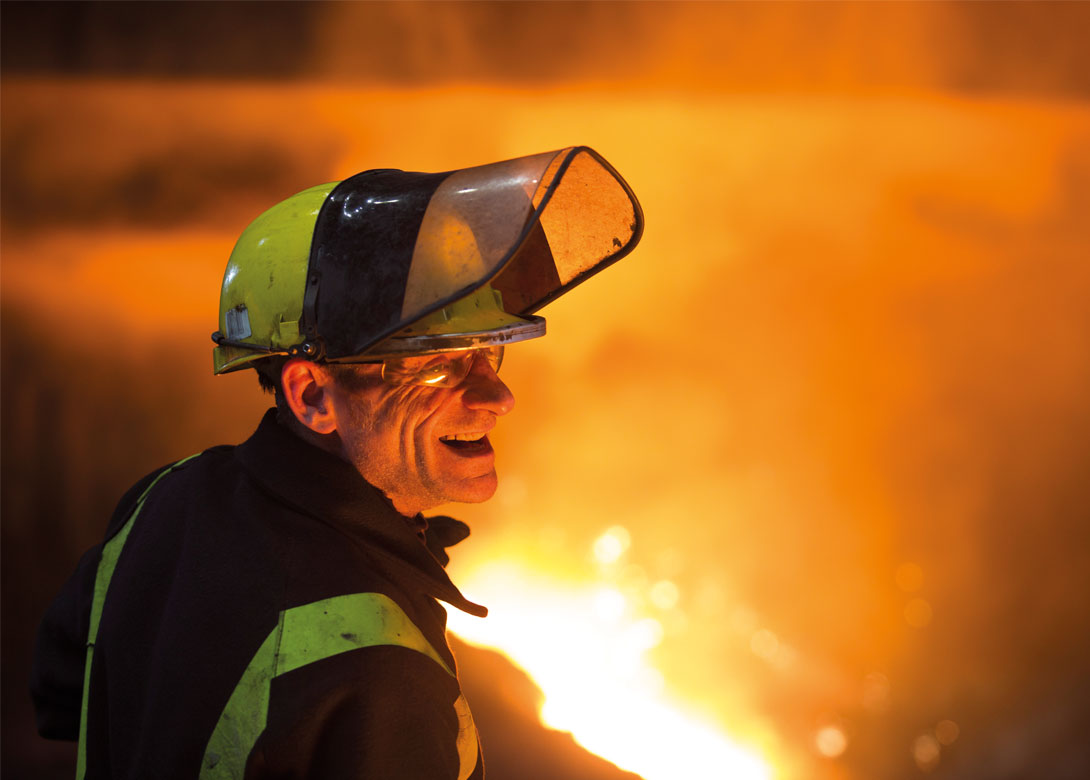
British Steel is making the biggest single investment in its manufacturing operations for a decade, committing GB£50 million to a major upgrade of its wire rod mill. Executive Editor Phil Matten met with wire rods managing director, Richard Sims, and project director, Mark Cunningham, to hear more about the background and implications of this huge project.
“When you have a basic oxygen steelmaking manufacturing base you have a high-quality capability upstream supply*,” opens Richard Sims. “However, our ability to extract the maximum value from that in the rolling process has dwindled over the years, as others’ capabilities have changed, and customer requirements have increased. So, the ability to manufacture more sizes at much tighter tolerances is at the heart of this crucially important investment.”
Richard was appointed managing director for the wire rods business in October 2016, following Greybull Capital’s acquisition of the Long Products Europe business of Tata Steel. Starting as a plant engineer in 2003, he subsequently spent four years at the Scunthorpe plate mill, before taking works management and director level responsibilities at sister sites in the north east of England.
“Bear in mind the history of British Steel,” he says. “It’s not news to anybody that the background has been very challenging, which makes this an enormous vote of confidence in the management team by the shareholders. For all of us who have worked in the industry and not seen anything like the investment we would have liked to have seen, having this opportunity has generated a real appetite to do something truly exceptional with the assets we have.”
Mark Cunningham, who brings his own extensive steel production experience to the project directorship of the new investment, reflects on the history of the wire rods business. “The current asset was installed in 1976 and at that time was seen as the state of the art. Before that it was small weight coils and very slack tolerances. At the time, the new installation was recognised as world beating, allowing long run production for downstream wire drawing.”
The mill’s output was almost entirely dedicated to a healthy UK wire drawing market through to the early 1990s. “At that point this mill was producing around one million tonnes of prime product, of which 60% was going into the UK market.”
“The diameter range was from 5.5mm to 13.5mm,” explains Mark. “The Phoenix agreement defined that Scunthorpe produce wire up to 13.5mm, and Rotherham produced bar from 13.75mm upwards. Several incremental investments followed – developing water boxes and improving the Stelmar cooling technology to achieve greater consistency. While still largely driven by wire drawing that had beneficial secondary implications for other sectors like cold heading.”
“As wire drawing moved East, and our domestic base drastically reduced, we needed to look at alternative markets. As we moved more and more to cold heading we had to achieve tighter tolerances.”
In 2007 there was a substantial upgrade targeted specifically at reducing the cost of feedstock, which entailed more than GB£30 million investment to install a new reheat facility. “The new reheat furnace eliminated a series of processes at the bloom and billet mill and, importantly for the new project, is still classed as the best available technology. Still top of its game it provides a huge benefit for the asset as we take it forward now.”
From 2010 onwards, the mill transferred more and more output to the component manufacturing arena – wire for cold heading and for free cutting or machining precision components. “These were markets that demanded a different dynamic from the mill,” explains Mark. In 2003 maximum output diameter increased to 15mm, to meet requirements from other parts of the group. “That started us thinking about how big we could really go,” says Mark. “In the last couple of years, we successfully stepped up to 17mm. However, we could see we had reached the limits of the physical capability of the current asset.”

“Over the last eighteen months we have been asking ourselves how we can develop the asset, maintain the volume, and give tighter tolerances. We know our microstructure is excellent: The questions were how we developed size, shape and tolerance to determine our future in the market.” That meant several months of “exploring the art of the possible”, drawing on the deep reservoir of knowledge at British Steel to define the metallurgical characteristics of grades to meet current market and future market requirements. Intensive discussion both upstream on the steel supply side and with key customers focused the size ranges and metallurgical qualities that needed to be achieved.
“A fair chunk of the new products will go to existing customers who understand how we do business and the steel pedigree we have, and with whom we have solid trading relationships,” explains Richard. “We clearly recognise the lightweighting and improved strength requirements from the market, and know the transformation needed to futureproof our business – and leap frog it into the future.”
The management team had a clear vision of what they wanted to achieve – time to move from the what to the how. “The Greybull approach since 2016 has been really fantastic. They have been enormously supportive, taking an active interest in the day-to-day operation of the business,” says Richard. “They have transformed us from being a manufacturing division of an international conglomerate to become a focused business unit. What they have said to MDs like myself is: ‘So now what and how are you going to take your business forward?’.
“We were all very aware that we could not just sit here and wait for the next recession to roll past – we knew what would happen. There is a real window of opportunity now and a massive commitment to make these the most significant years in our history”.
Adapting to a very different shareholder culture brought its challenges. “We found it initially quite hard. In a traditional and mature industry, it’s not always instinctive to make rapid change.”
“Focusing on the really big things for the wire rod business has been very important,” Richard says. “The acquisition of FN Steel and the upgrade here have been really valuable in providing really big things to which we can dedicate quality resources. We’ve been just as busy adopting automotive aligned improvement techniques, such as Six Sigma, and convincing every single person they should have their own improvement project – dedicating part of their daily energies to making it a better place.”
“However, while that reaps really important long-term benefits, it doesn’t quite have the same excitement as a GB£50 million investment project. Mark and I did a number of employee briefings. Over the years, and it doesn’t matter where you’ve worked in this industry, there’s been talk about big investments coming along. So, there is a level of ambivalence – ‘we’ll believe it when we see it’ thinking.”
“When we said, ‘no, we are going to do this, and we are not going to stop until it is done -and by the way it will happen’ there was a feeling around the room of ‘Hallo, this is a bit of a different approach’.”
“For the management team a distinctive approach was also demanded. “Achieving the sign off and funding for this project would have been challenging under any ownership,” explains Richard. “However, it really brought home to us just how entrepreneurial and rigorous our thinking now needed to be to arrive at the point we could confirm to our own people and the market generally that this really was a goer.”

And that is how it should be, he is convinced. “Our customers, particularly in the automotive industry, expect a supply partner that is efficient, agile and modern – able to demonstrate how it can change. We also have to demonstrate how we are pushing our suppliers, upstream in British Steel, to be more effective, efficient and delivering higher quality all the time.”
Starting in October a 55m extension will be added to the mill building to accommodate the cooling phase of the new line. In preparation for that a new laboratory building has been completed, relocating it from the end of the current line and adding a second storey.
“By the end of the 18 month project we will literally have a new manufacturing line, installed in a phased approach, to allow us to keep the existing asset rolling to service our customers.” Mark adds: “Then we will begin trialling material from the new line with customers. For some that transition will be quite quick, for others we will need to do more work with them.”
“Ultimately we will move from the four lines today to a single line but the through volume will still be around 750,000 tonnes per year. Within that one line there will in effect be three lines, so different sizes and combinations will go through different parts of the line at different times. That allows us to do maintenance and size changes on different parts, which maximises the utilisation of the asset.”
“The future of wire rod is not going to be so much about the physical diameters,” concludes Richard. “It is going to be far more about the metallurgical aspects of the rod we are making. We have a very strong R&D facility, we understand steel making, we understand our process, and now we will have a state of the art manufacturing line. We truly are building stronger futures with high-quality steel products.”
*The British Steel wire rod mill at Scunthorpe is part of an 810 hectare integrated steel making site, with its own coke ovens and sinter plant, preparing feedstock for four blast furnaces, named after four English queens – Mary, Bess, Anne and Victoria. In modern convertors, the basic oxygen steelmaking process is used to produce high grade steel, which is then refined as necessary through secondary steelmaking processes, to meet the demanding expectations of British Steel customers throughout the world.
To see it all in action watch: https://www.youtube.com/watch?v=RoqGaotMuRg

Biog
Having held senior management roles in leading automotive and fastener businesses, Phil joined Fastener + Fixing Magazine as editor in 2002. Convinced there is no substitute for ‘being there’, over 17 years of visits and interviews around the world means he has accumulated an extraordinary knowledge and perspective of the global fastener industry, reflected in his incisive and thought provoking reporting.








